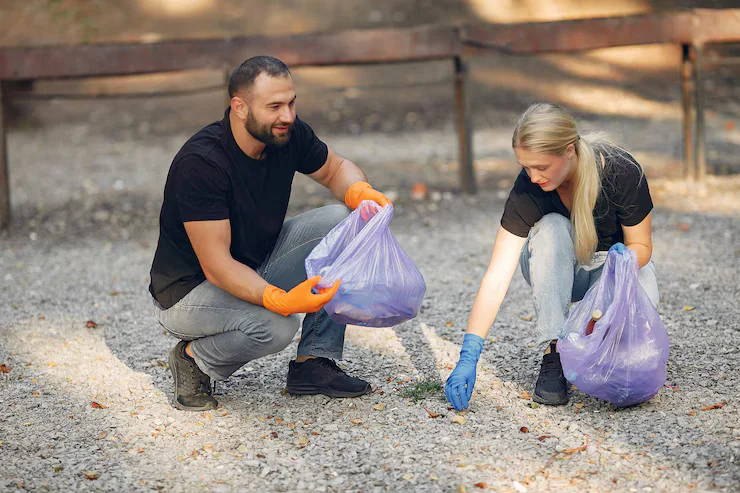Looking for top-quality trash bags or heavy-duty contractor bags that won’t let you down? You’re not alone.
Most people don’t think much about the plastic liners they use every day. But when the bag splits mid-carry or leaks across your floor, the wrong choice becomes a real mess. Whether you’re tossing kitchen scraps or hauling debris on a job site, the right garbage bag makes all the difference.
And if you’re sourcing bags for your business, office, or commercial cleaning crew, it pays to stick with a supplier known for consistency and quality.
This guide breaks down what garbage bags are made of and helps you choose smarter every time.
Everyday Impact of Smarter Waste Choices
The type of garbage bag you choose affects more than convenience.
Poor-quality bags can rip, leak, or create more plastic waste. Over time, those daily choices pile up — literally. On the other hand, using the right materials and understanding how they work helps:
- Reduce plastic waste
- Lower replacement costs
- Improve handling of sharp or bulky trash
- Support greener manufacturing
Making smarter decisions about garbage bags is one of the easiest changes anyone can make at home, in business, or on a construction site. But it starts with understanding what they’re made of.
The Core Materials Used in Garbage Bags
Most modern trash bags are made from polyethylene, a versatile type of plastic. But not all polyethylene is the same. Here’s what you need to know.
Low-Density Polyethylene (LDPE): The Flexible Favorite
LDPE is soft, stretchy, and highly resistant to tearing. That’s why it’s the go-to for kitchen trash bags, commercial liners, and light yard work.
Think of LDPE like a rubber band. It bends, it flexes, and it can handle odd shapes without snapping.
Pros:
- Flexible and durable
- Good resistance to punctures
- Ideal for wet or irregular waste
Cons:
- Not as strong with heavy loads
- More plastic used per bag (thicker)
High-Density Polyethylene (HDPE): Tough but Thin
HDPE is used in thin but surprisingly strong garbage bags. It’s the secret behind those crinkly bags you find in public restrooms or office bins.
Think of HDPE as the crisp dollar bill of plastics — firm and efficient, but not great with sharp edges.
Pros:
- Cost-effective and lightweight
- Resistant to chemicals
- Less plastic per bag
Cons:
- Tends to tear with sharp items
- Less stretchy than LDPE
Linear Low-Density Polyethylene (LLDPE): The Middle Ground
LLDPE combines the best of both worlds. It’s stretchier than HDPE and stronger than LDPE. Most contractor bags use LLDPE or LDPE blends for maximum strength.
If LDPE is a rubber band and HDPE is a crisp bill, LLDPE is a bungee cord. Flexible, strong, and built for stress.
Pros:
- Great puncture and tear resistance
- Excellent load capacity
- Ideal for industrial and contractor use
Cons:
- Slightly more expensive
- Heavier than HDPE
Material Comparison: Strength, Stretch, and Sustainability
So, which type of bag is strongest? Which one gives you the best bang for your buck? Let’s compare the three main types of polyethylene garbage bags — LDPE, HDPE, and LLDPE — on the things that matter most.
Which One Resists Punctures Better?
Puncture resistance is key if you’re tossing sharp or irregular items. Broken glass, food scraps with bones, pointy packaging — they all push your bag to the limit.
- LLDPE leads the pack. Its flexible structure helps absorb pressure without tearing.
- LDPE offers decent resistance, but it’s more prone to puncture than LLDPE.
- HDPE is rigid and thin. Once it’s punctured, it tends to tear fast.
Best for: Heavy-duty trash, renovation waste, jagged or irregular materials → LLDPE bags
What to Use for Sharp vs. Soft Waste
Not all trash is created equal. Different types of garbage call for different bags.
- Sharp or bulky items? Go with LLDPE or contractor-grade LDPE. These are your workhorses.
- Lightweight, soft waste? HDPE handles tissues, food wrappers, or dry office waste without waste.
- Mixed household trash? LDPE bags work well in kitchens and bathrooms.
Pro tip: Don’t just choose by gallon size. The material is what makes the bag fit for purpose — or not.
Weight Capacity and Stretch Resistance Breakdown
Strength isn’t just about not tearing. It’s about how much weight your bag can handle before stretching out of shape, or worse, snapping when lifted.
- HDPE bags are surprisingly strong for their thickness, but they lack stretch. That makes them prone to sudden tears under pressure.
- LDPE stretches easily and has decent holding power, but it can sag or distort with heavier waste.
- LLDPE offers a balance — it stretches and holds its shape under heavy loads.
Think of LLDPE like an elastic cargo net. It grips tight, stretches when it needs to, and doesn’t snap easily.
Additives & Enhancers: What’s Mixed In?
Garbage bags aren’t just plastic. Manufacturers often add extras to improve function or appearance:
- Colorants: Black hides contents, white matches décor
- Scented additives: Helps with kitchen or bathroom odors
- Anti-static agents: Stops cling when dispensing from rolls
- UV stabilizers: Protect bags stored outdoors
- Biodegradable compounds: Break down under the right conditions
But not all additives are harmless. Scented bags, for example, can irritate people with allergies. Always check the label if you have sensitivities.
Pros and Cons of Recycled Garbage Bags
Recycled bags sound great. And they often are, if used correctly.
Post-consumer recycled resin (PCR) and post-industrial resin (PIR) both help reduce waste. But they come with trade-offs.
Pros:
- Lower carbon footprint
- Less plastic waste in landfills
- Great for light-duty jobs
Cons:
- Often less durable
- May tear more easily
- Not ideal for sharp or wet trash
Recycled bags are perfect for paper waste, dry trash, or office use. But for heavier loads? Stick to virgin resin or blends.
Compostable vs. Biodegradable: What’s the Difference?
These terms get thrown around a lot. But they aren’t the same.
- Biodegradable means the bag will eventually break down. It could be years.
- Compostable means it will break down quickly in compost conditions.
Important note: Compostable bags need heat, moisture, and microbes, like those in industrial composting facilities. Most home bins won’t cut it.
So, unless you compost regularly or live in a city with compost pickup, compostable bags may just act like regular plastic.
Before you go, this next article might answer your next question.
Are “Green” Trash Bags Really Better?
They can be. But it depends.
Many green-colored bags simply use less plastic or contain recycled content. Some are truly compostable. Others? Just clever marketing.
Before you switch, ask yourself:
- What kind of waste do you throw out the most?
- Do you have access to composting or recycling?
- Are you willing to trade durability for sustainability?
Sometimes, the greenest choice is using a stronger bag less often, not buying dozens of thin ones that rip and double your usage.
How to Choose the Right Material for Your Needs
A few quick rules of thumb:
- Daily household waste: LDPE or blended bags with decent stretch
- Construction, renovation, or yard work: LLDPE contractor bags
- Office and bathroom bins: HDPE for lightweight, dry trash
- Eco-conscious disposal: Compostable or recycled content for soft waste
Look for labels. Check the specs. And when in doubt, go one level stronger than you think you need. It’ll save you mess — and money.
Smarter Bag Choices for a Cleaner Future
Garbage bags aren’t glamorous. But they matter.
From your home kitchen to commercial dumpsters, these plastic liners play a role in waste management, cost savings, and environmental impact. Understanding the differences in materials — LDPE, HDPE, LLDPE, and everything in between — helps you make better choices.
Not just for convenience. But for your wallet. And for the planet.
So the next time you restock your trash bags, pause for a second. Check the label. Think about what’s going into your bin — and the bag it’s in.
Because smarter waste choices start with the bag you can’t see past… but shouldn’t overlook.
If you enjoyed this post, you’ll love what’s featured on 2A Magazine.







